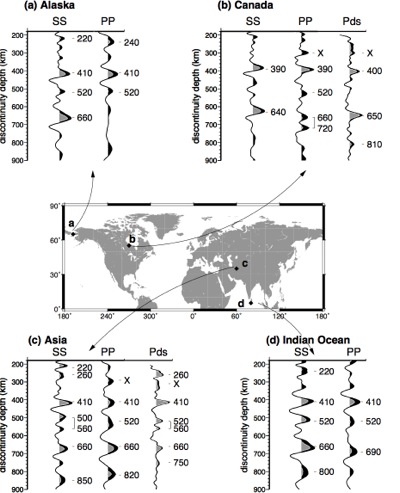Mantle Discontinuities
An important issue in seismology is the global and regional characteristics of velocity discontinuities in the Earth’s mantle. Some of these represent known phase transitions in mantle minerals. The existence and nature of such discontinuities is very important for our understanding of the internal dynamics of the Earth (such as mixing between the upper and lower mantle) and provides the input needed by mineral physicists to connect seismic discontinuities with mineralogical phase changes.
We have made the first global map of the Lehmann discontinuity at 220 km depth, and interpreted the observations as most probably being caused by a change in deformation mechanism. We also discovered that the mid-transition zone discontinuity at 520 km depth is ‘split’ in many regions and provided the first observations of the 660 km discontinuity using PP precursors. Previous studies had interpreted these discontinuities in terms of phase transitions in olivine. Our work, on the other hand, shows that additional phase transitions in garnet are needed to explain complex features seen in the seismic data. These results fundamentally change our ideas of how the mantle works and suggest that mantle mixing may vary regionally rather than being a globally unified process and that the Earth’s transition zone is more compositionally heterogeneous than previously thought.
Our aim is to build a global data set of many different data types that can be exploited to study mantle discontinuities and compared with new mineral physical results. During the last few years, we extended my original SS and PP precursor data set to receiver functions. More recently, we have been working on short period P’P’ precursors, which give puzzling results quite different from long period PP precursors, suggesting that the mineralogical properties of transition zone discontinuities may be frequency dependent. At the moment, we are focussing on two regional studies using receiver functions, one in Iceland to image the mantle plume and the other in Europe to study the regional subduction.
Reviews
- Deuss, A., Andrews, J. and E. Day (2013). Seismic observations of mantle discontinuities and their mineralogical and dynamical interpretation, in Physics and Chemistry of the Deep Earth, edited by S. Karato, p.297-323
- Deuss, A. (2009). Global observations of mantle discontinuities using SS and PP precursors, Surveys in Geophysics 30 (4-5), p.301-326
Key publications
- Day, E. A. and A. Deuss (2013). Reconciling PP and P’P’ precursor observations of a complex 660 km seismic discontinuity, Geophysical Journal International 194 (2), p.834-838
- Andrews, J. and Deuss, A. (2008). Detailed nature of the 660 km region of the mantle from global receiver function data, Journal of Geophysical Research 113 (B06304), doi 10.1029/2007JB005111
- Deuss, A. (2007). Seismic observations of transition-zone discontinuities beneath hotspot locations, Geological Society of America Special Papers 430: Plates, Plumes and Planetary Processes, p.121-136
- Deuss, A., Redfern, S.A.T., Chambers, K., and Woodhouse, J. H. (2006). The Nature of the 660-Kilometer Discontinuity in Earth’s Mantle from Global Seismic Observations of PP Precursors, Science 311 (5758), p.198-201
- Deuss, A. and Woodhouse, J. H. (2004). The nature of the Lehmann discontinuity from its seismological Clapeyron slopes, Earth and Planetary Science Letters 225 (3-4), p.295-304
- Deuss, A. and Woodhouse, J. H. (2002). A systematic search for mantle discontinuities using SS-precursors, Geophysical Research Letters 29 (8), p.90-1–90-4
- Deuss, A. and Woodhouse, J. H. (2001). Seismic Observations of Splitting of the Mid-Transition Zone Discontinuity in Earth’s Mantle, Science 12 (5541), p.354-357
